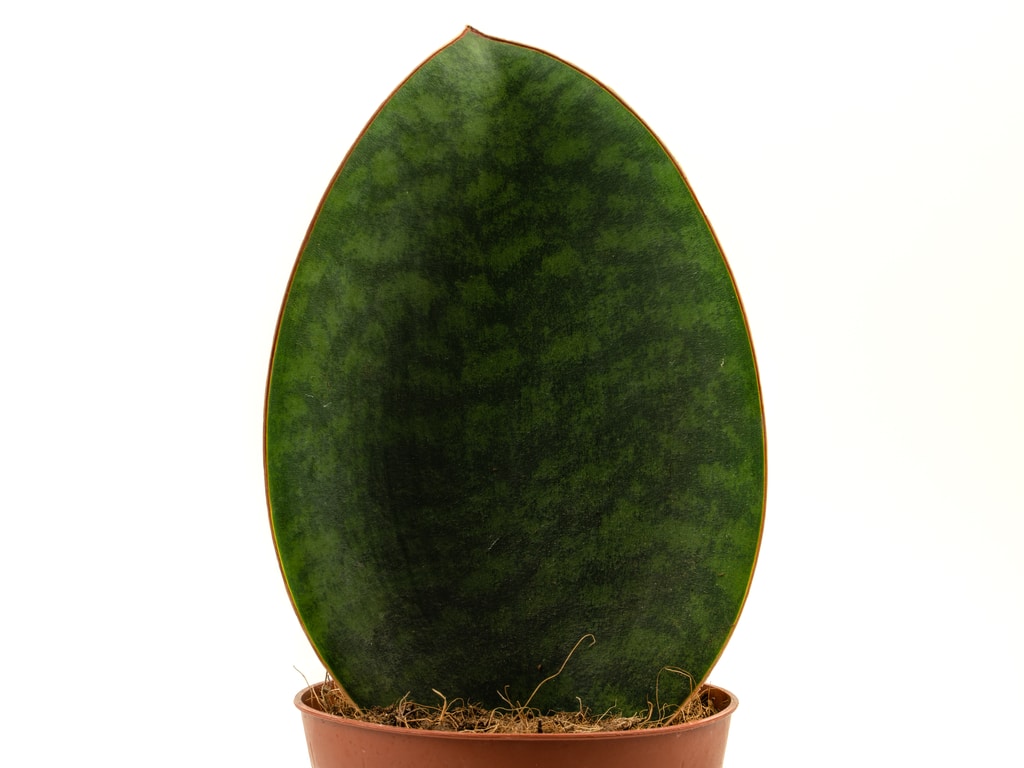The Whale Fin Sansevieria (Dracaena Masoniana) is a type of Snake Plant that can make for a stunning addition to your interior if you like lush and thick gigantic leaves. Sometimes also called Mason’s Congo Sansevieria, this variety of plants displays a characteristic central leaf that resembles a whale fin (like the name suggests).
If you would like to learn more about this plant (and learn how to care for it), you are in the right place. In this essential guide, you’ll find everything you need to know to have a thriving Whale Fin Sansevieria at home.
What you Need to Know About Whale Fin
This type of Sansevieria is one of the most popular choices for beginners for its easiness of growing in most environments and conditions. With its dense and brilliant leaves mottled with deep green patterns, this plant makes a perfect addition to a bathroom or a living room. If you are not an expert with plants, you won’t have to worry too much about this one. It can survive for weeks without water.
While stunning, you might have to be careful with this one: this unusually shaped plant can be mildly toxic if ingested by pets and kids.
How to Care for Whale Fin Sansevieria Plant
Sansevieria can easily fall under the category of easy to care plants. Whale fins are not an exception. Indeed, these plants are versatile and resistant, as long as you fulfill their basic needs. As you’ll learn in the following sections, taking care of them is not challenging.
However, you’ll want to ensure to provide them with enough lighting, necessary amounts of water, and optimal soil conditions. Jump to the following sections to learn all you need to have thriving Whale Fin plants in your indoor space.
Light Requirements
You may have heard somewhere that Sansevieria can thrive in low-light conditions. However, that’s not the case. Indeed, these plants are native to Central Africa and require plenty of indirect sunlight to thrive. While they might survive under low lighting, to have them thriving, you’ll need to place it somewhere facing east or south. Locating this stunning plant in a dark corner of your home will result in slow growth and an unhealthy-looking plant.
If you can, place your plant as close to a window as possible. They won’t suffer from sunburn, so if you can’t add sheer curtains, don’t worry. If you only have North-facing windows at home, place it somewhere it will get some light during the day: it will be fine. Under such circumstances, consider adding some direct sun for a couple of hours to ensure adequate growth. You may want to open the window or move your plant to the porch.
Water and Soil Needs
Whale Fin Sansevieria don’t need frequent watering but will require a considerable amount of water between each session. Always ensure the soil is dry before adding more water to prevent overwatering and other issues that will damage your plant.
You can check the soil conditions with your fingers before watering. Water until it flows out the drainage holes. Don’t forget to discard the excess to prevent root rot. Allowing your whale fin to sit in water is something you should avoid at all costs. If your plant is small enough, you can reduce mess by taking it to the sink to water it.
Ensure you plant your Whale Fin in well-draining soil. Use two parts of succulent mix and one part of perlite or pumice to improve drainage. Despite not being succulent, Whale fin thrives in similar conditions. You can select any container for your plant, provided it has drainage holes. Terracotta pots are ideal: they dry out quickly and help prevent overwatering.
Temperature Requirements
These plants do well in most indoor conditions and tolerate household humidity leaves. They prefer dry environments, so you won’t have to worry about getting a humidifier.
What USDA climate zone can it survive?
Whale Fin Sansevieria can live outdoors in USDA zones between 9 to 11. Even there, you’ll want to ensure you protect them from harsh wind, low temperatures, and too much direct sun.
Fertilizer
Whale fins are light feeders but will still benefit from low nitrogen fertilizer during the summer and spring. Remember that fertilizing isn’t a magic process that will eliminate your problems. Ensure your plant receives proper lighting and watering before thinking about it.
Common Diseases
Sansevierias are tough plants resistant to most pests and diseases. However, when growing outdoors, they might be attacked by spider mites. Luckily, you can treat your plant with insecticidal soap to eliminate the problem.
Common Problems
While this plant doesn’t suffer from many problems, lack of adequate care might cause it to show symptoms you have to take care of. Luckily, most issues are easy to reverse. Wilting, yellowing, and mushy leaves are signs of overwatering. Slow growth and dull leaves might indicate a lack of lighting or little watering. Consider moving your plant to a different location. If things don’t seem to change, increase the amount of water you give.
Whale Fin Sansevieria Propagation
As we mentioned, whale fins grow slowly. You may have to wait before getting new growth. Once you notice movement in your plant, you can think about propagating it. This process will also save your unhealthy plant if needed. The best way to propagate snake plants is doing it by division. However, you can only apply this method if your plant has more than one leaf.
To propagate your whale fins, remove the plant from the pot. Separate the new growth from the central stem by the roots. Be careful not to harm any roots, as they are sensible. Once you succeed in the division, plant the new leaf into a different container with a proper soil mixture. Ensure you maintain it moist to increase its chances of adapting to the new environment. You can also propagate this plant in water or by cuttings. However, both methods are much slower.
Whale Fin Sansevieria: The Bottom Line
If you are looking for an outdoor plant, but don’t know where to start, consider getting a Whale Fin snake plant. Of all the varieties, this one is the easier to care for and the most adaptable one. Under the proper light and soil conditions, this plant will thrive.

